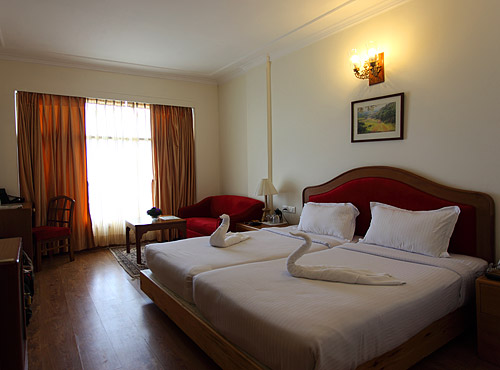It is not easy to convince myself that people actually live in these places. My GPS continuously recorded altitudes above 13,000 feet. We did not sight even one tree despite walking for hours together. The sun happily burned every inch of unprotected skin, peeling away flakes of epidermis. Oxygen levels were so low that climbing even a hundred feet felt like a day long arduous task. At times we climbed over 15,000 feet, where the thinning air laughed at our struggling bodies. Winter temperatures apparently fall twenty below zero or even lower. For the people of Spiti Valley, this was everyday life.
Before we started the long walk from Komic to Dhemul, Tenzin Lama, a monk at Komic monastery (altitude – 14,700 feet) said it takes about two hours. “We normally start after lunch,” he mentioned casually, “and walking slow and easy, we reach Dhemul (altitude – 14,200 feet)well before dark.” He was trying to assure us that there is absolutely no need to hurry, or worry about the walk. While he talked, he was making Maggi and tea for all of us – an early lunch before we begin the long walk.
We had an amazing variety of estimates on the time it takes to reach Dhemul. Tenzin’s was the shortest, and he made it appear like a child’s play. The man who suggested us to make this walk had estimated five to six hours. The guide who accompanied us — Thekpa — was more cautious. He was watching over us and had assessed our strengths better. He thought we will require about eight hours.
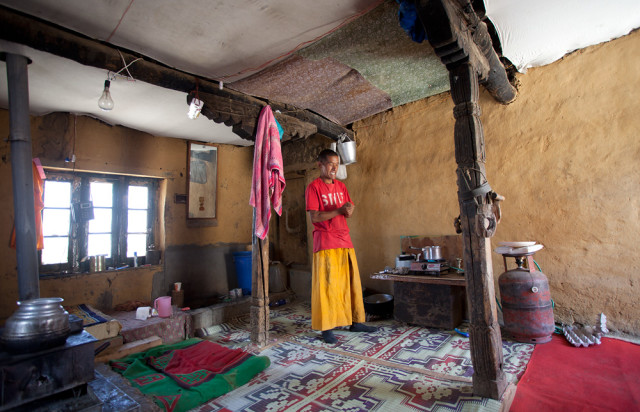
Lama Tenzin offered us tea and maggi before we embarked on the trek
It was eleven in the morning when we began conversations at Tenzing’s cozy little room at Komic Monastery. He was a cheerful chap who never seemed to stop talking, occasionally offering weird poses for our trigger happy group. When someone aimed the camera at him making tea, he would stand on one leg, other leg dangling in the air and his hands mimicking someone pouring tea from a kettle into a cup. The gang loved him instantly.
The good times lasted only as long as we were having Maggi with Tenzin. The struggle for oxygen began soon after we left Komic. On ascents, no matter how gentle it was, every step seemed like an attempt to carry a big ball of steel tied to the shoes. Descents were much bearable, but much of our way that day was a gradual climb. The views however, were something that justified the effort. Whenever we paused and looked back, Komic village appeared like a bunch of match boxes against a gigantic line of mountains that challenged the sky.
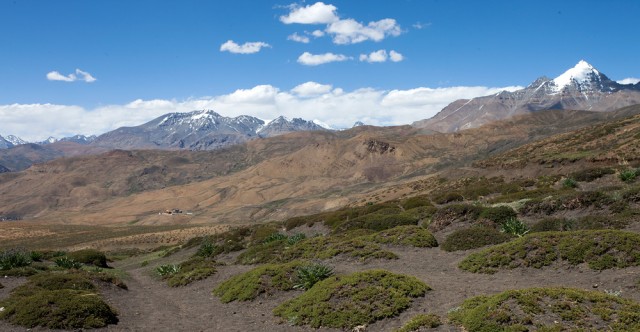
Komic was a small dot on the landscape. The snow-capped Chau Chau Kang Nilda Peak dominated the views.
With very little precipitation in the previous winter, many of the peaks far behind the village were unusually bare and brown. The tall Chau Chau Kang Nilda rose much higher than its neighbours and wore a shiny white that was worth the envy of its counterparts. On the opposite site, the mountains plunged steeply for more than two thousand feet into the valley of Spiti River, rising again to form another chain of snow-capped peaks. But most importantly, ahead lay a path that seemed to keep going upwards forever!
It must be about two hour’s of uphill journey before a short descent made a kind appearance. After the descent was a plateau-like area, full of a variety of thorny plants that had carpeted the earth. Thekpa, our guide, said that all those plants will begin flowering after the first rains in August and the earth turns purple with the efflorescence. The plants were so numerous and widespread in the plateau, it would be worthwhile coming here again to fill that scene in the eyes.
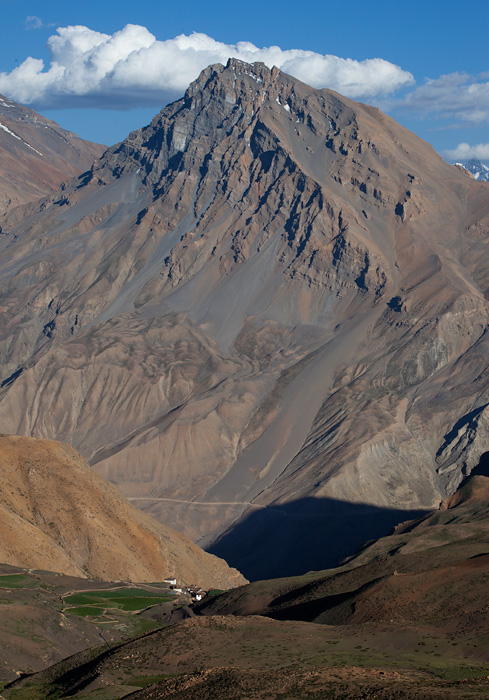
From the highest point of the trek, Dhemul Village appeared like a small spot trapped in the mountains.
After a short break and a short eat at the end of the plateau, it was time for a long and final ascent. It was nearly 5pm when we reached the highest point of the trek at 15,700 feet. Beyond the pass, we could see Dhemul village as a small spot trapped in the mountains. Now, it was a steep descent that we estimated to be a twenty minutes walk. The ever-cautious Thekpa suggested an hour. It turned out, he was right.
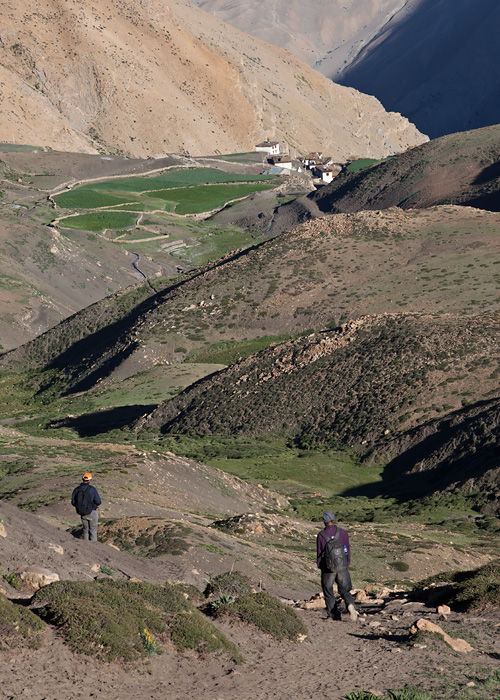
So near, yet so far. We thought it takes 20 minutes to get to the village. Our guide Thekpa suggested an hour. He was right!
We reached Dhemul at 6pm, a walk that took us a total of seven hours that included an hour of careless gallivanting off the path. Thekpa’s estimates turned out to be more reasonable than Tenzing’s.
Dhemul, much like Komic, was a village that appeared out of nowhere. It is amazing how people sustain in these villages, high up in the mountains and faraway from every other place. A hundred years ago when they weren’t touched by modernity, they lived an almost self-sustained life with the help of their flock of animals and subsistence farming. Sheep and yak provided them with milk, butter and meat while the barley fields gave them cereals. The fields are usually spread very close to the village and the villages are usually located next to a perennial stream that never dries up. Perhaps only salt and spices had to come from outside, may be from a long southern route via Kinnaur Valley. Their houses too, were built with locally available materials. The walls were of mud, while the roof was held in place with poles of willow that were grown all around the village. Every village in Spiti has a similar ecosystem, which looks like a verdant escape in the otherwise desert landscape.
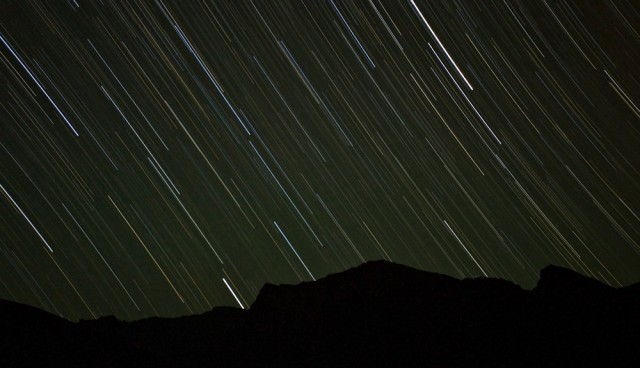
A starry night at Lalung Village
Today, many of these villages are connected by road. A road is perhaps the most important thing that changes the lives of people forever. People still rely a great deal on their yak, sheep and barley fields. But they now have access to comfortable clothing that comes from outside, get to sleep in more comfortable mattresses, cook with LPG, eat rice and wheat besides barley and buy vegetables that they would never have access to earlier. Electricity poles too have made their way to many villages. Power supply is limited and erratic and is often backed by solar panels, but more often than not, people can cook their dinner under a bulb watching television. A more recent phenomenon – direct to home television – has invaded the homes rapidly, thanks to the receivers given away by Prasar Bharati.
Despite all these modern comforts having arrived in Spiti, I still can’t stop wondering how people ever lived here. The extreme weathers and limited resources still governs their frugal and efficient lifestyle. In the last two decades, Spiti’s Villages have routinely broken several records, such as the highest village in the world with permanent habitation, highest village with motor roads, highest village with access to electricity, highest fuel pump in the world, highest village with a post office and so on. While we get to hear about some of these statistics at every turn, not every one of them may be necessarily true.
Perhaps these harsh conditions of living have made Spitians understand human sufferings better than anyone else, and be of assistance to everyone in need. At the village, after we had comfortably settled in, I realized that we did not know where our guide was staying. An attempt to look for Thekpa alerted the entire village and the news spread quickly to wherever Thekpa was, who came to meet us. The moment someone got to know, several villagers had gone looking out for him, taking up the task as a personal mission. Later that night, the kind lady of the house took out the best vegetables in the house (aubergines, at 14,000 feet) to make our dinner. The villagers took care of us like a bunch of old relatives who were visiting after a long time.
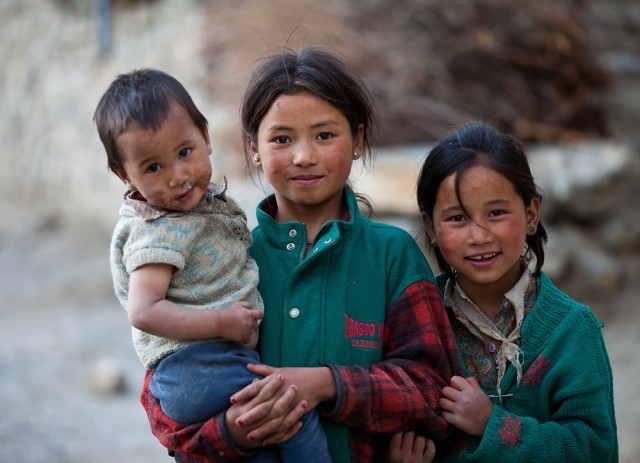
These girls posed for a picture at Lalung Village.
The next morning, we were scheduled to make another long walk – this time thankfully downhill all the way – to Lalung Village (altitude – 12,300 feet). But the news had arrived that the annual festival at the monastery in Ki Village is scheduled on the same day. We changed our plans and boarded a vehicle to Ki, spent the day at the festival and took the road to Lalung Village in the evening.
The festival deserves another complete post, but the images and a brief report is available here – images of festival at Ki Monastery.
I spent a few days in McLeodganj or Upper Dharamsala in November, walking on its narrow roads and gazing at the mountains, trees, birds and Tibetan Buddhists. Being the home of HH Dalai Lama, you see Buddhist Monks and Buddhist symbols in every corner of McLeodGanj. Before I arrived at Dharamsala, I had made plenty of plans about places to see and things to photograph. I was getting a feeling that my three days would be so packed that I will hardly manage to get the feel of the place. But there was a sudden change the moment I arrived in town. I kept my camera away and spent most of my time in Dharamsala walking in the beautiful hills, often aimlessly and randomly. I did not find the need for a schedule. I did not find the need to go see all things that must be seen. I did not wish to get busy with the camera. I simply let the days pass from moment to moment and spent most of my time walking in the hills. Only on my last day in McLeodganj did I spend a few hours taking pictures. Here are some of the images of the Buddhist world in Dharamsala captures in those few hours.
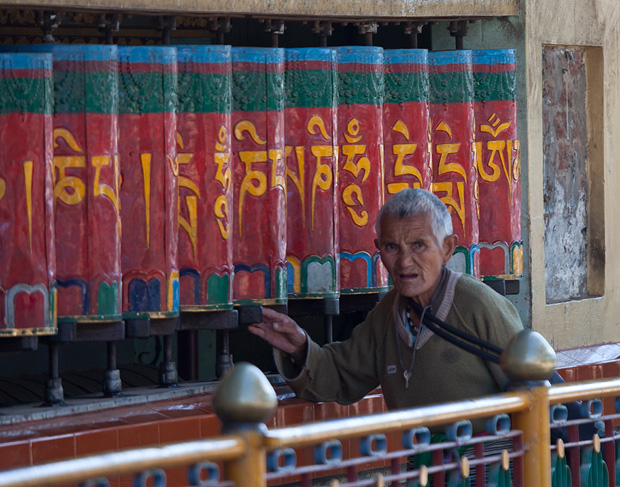
Prayers wheels on the way to Dalai Lama Temple in Dharamsala
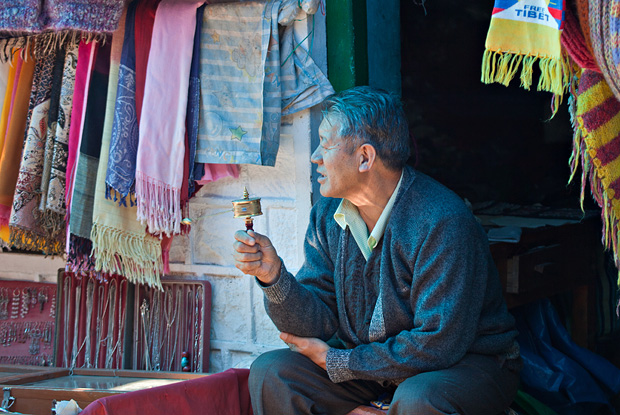
Prayer wheels – handheld ones.
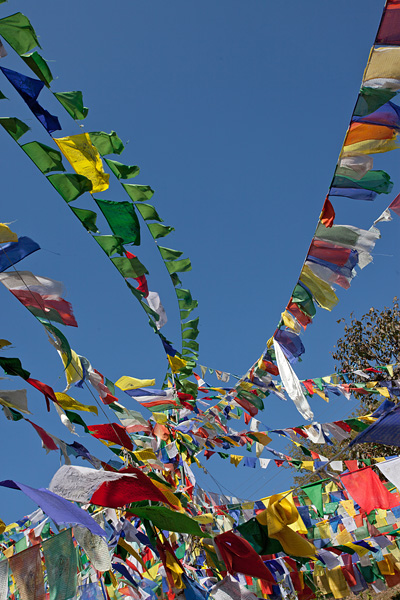
Prayer flags fluttering near Dalai Lama Temple
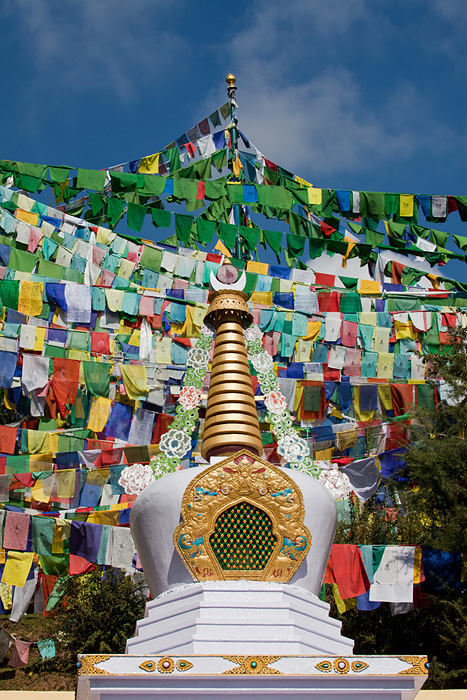
A stupa or chorten with prayer flags in the background
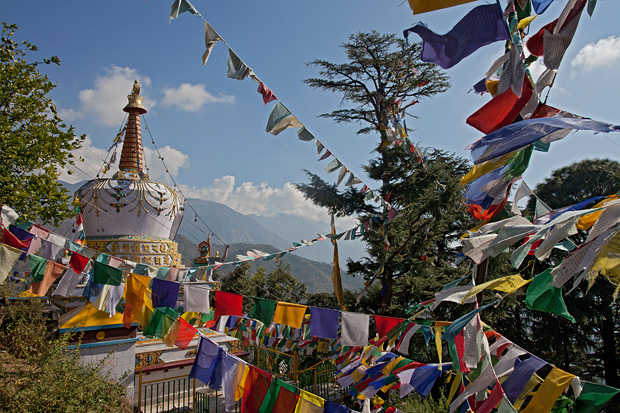
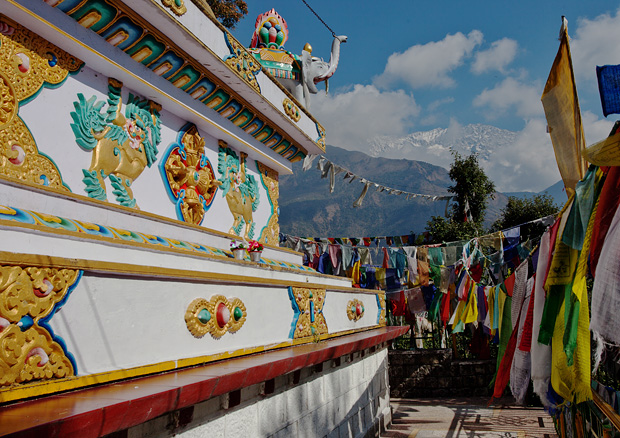
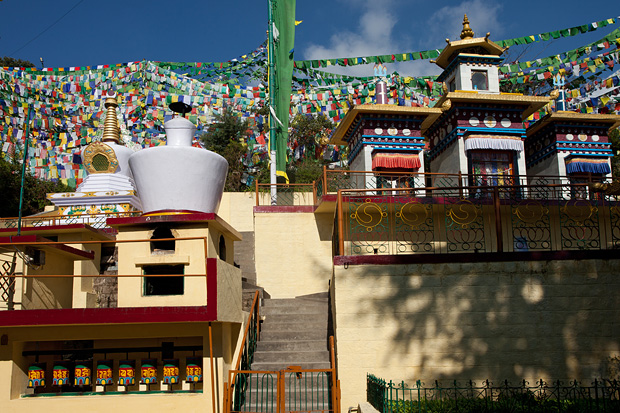
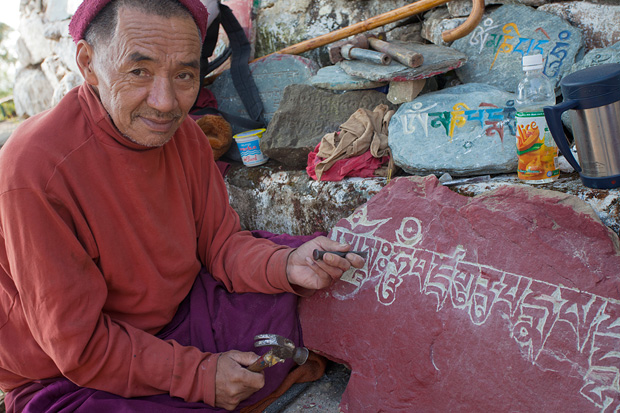
A Buddhist Monk carving mani stones. Mani stones are tablets bearing the sacred mantra – Om Mani Padmehum
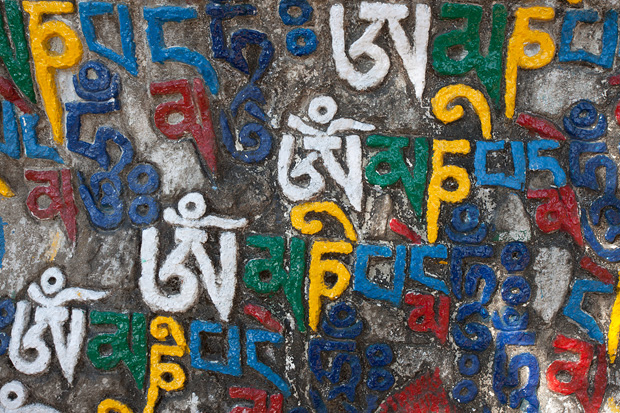
A mani stone
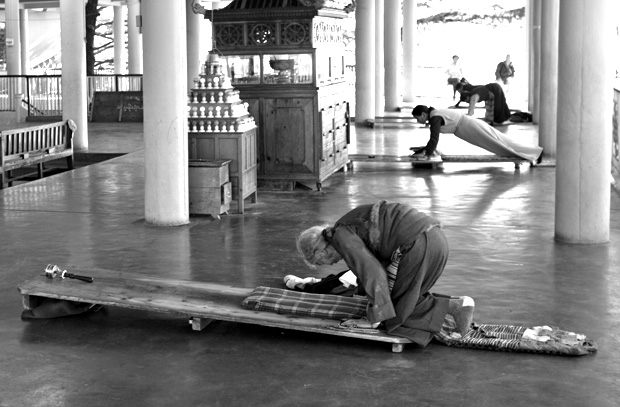
Devout Buddhists prostrating at the Dalailama Temple
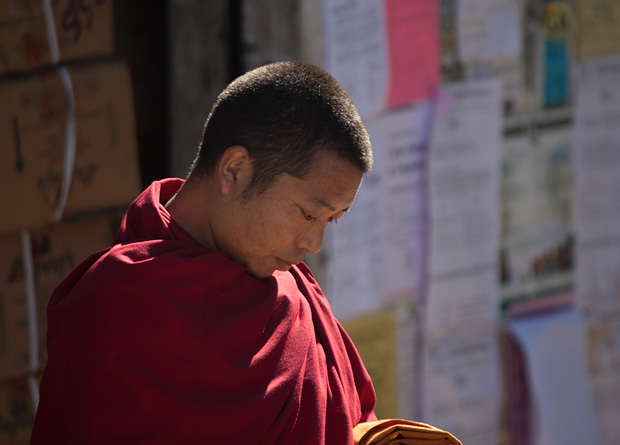
A monk on the streets of McLeodganj
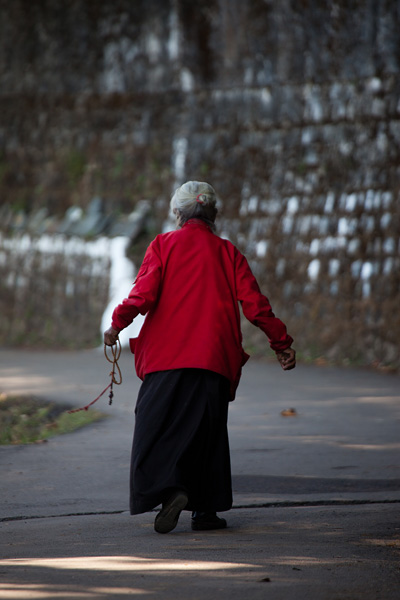
Finally.. an elderly lady with rosaries in hand, walking on the circumambulation path around Dalailama Temple
Prints of all the images available. Request for prints.
I woke up bleary eyed, took out my toothbrush and casually pulled the curtains before heading to the bathroom. One look outside the window, I threw away the toothbrush and rushed down with my tripod and camera. The view of the orange skies and sun surfacing over jagged ridges was something I did not want to miss. Toothbrush could wait.
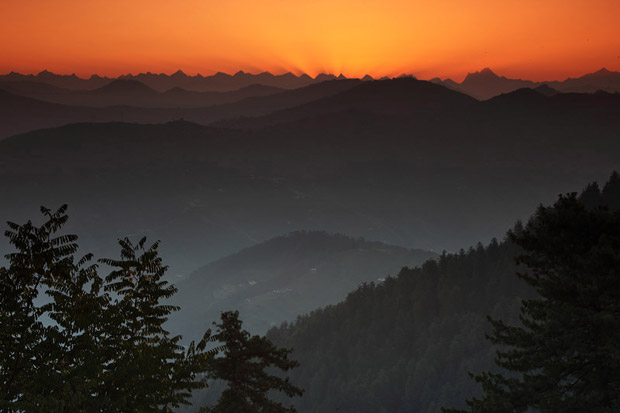
Sunrise at Mashobra
I can go on to explain how the sky changed colour, how the ridges were stacked up below a brilliant sky and how I felt exalted after witnessing the drama. But words can make the whole affair dull and stilted.
Birds arrived soon after sunrise. A small bunch of black throated tits took fancy to a tree next to me, where they hopped on from branch to branch, probably looking for breakfast. A pine tree hosted a brown thrush-like bird, which glittered on a shaft of sun rays that penetrated through the leaves. I don’t know the names of much of Himalayas bird species, but sometimes names do not matter. It can be like watching a little girl run around and giggle in a nice quiet place; it doesn’t matter what she is called.
Waking up early in the morning has its good effects on you. But on this particular day, goodness did not last beyond breakfast. I was spending my days at Mashorba, a village near Shimla on invitation from Club Mahindra. Holidaying with a small bunch of travel writing fraternity, I had four good days spent amidst the mountains. The holiday had a few dull moments too, and it was one such day of dullness. A filling breakfast later, we spent a good hour waiting to be rescued from a traffic jam in Shimla and drove further on a seemingly never ending highway past hundreds of vehicles, ugly towns, a terrible accident before finally reaching Kasauli in the middle of the day.
Kasauli was recommended as a great place to go by one of our fellow travellers who himself decided to go elsewhere that day. “It’s a nice place, go to Kasauli,” he had told us, and we had immediately finalized our plans for the day. One of us asked our driver as we approached the town, “what is there to see in Kasauli,” for which he had casually replied, “market hai, mandir hai, sunset point hai” – ‘there is a market, there is a temple, there is a sunset point’. We had arrived there on mid-day and were planning to be back in Shimla by the hour of sunset. I understood why our man who recommended Kasauli to us decided to go somewhere else himself. But not to undermine the beauty of the place, it is a quiet and nice cantonment area – a great location provided you are an army major and have a cozy house to live there. Not otherwise.
After a quick walk around Kasauli, we were back to what we were doing before – driving through a highway past hundreds of vehicles, ugly towns and waiting to be rescued from a traffic jam in Shimla.
They say you have to go through some pain to be able to appreciate all good things in life. Indeed, remaining days in Shimla were spent appreciating those good things. In the small town of Chail where we went next day, I appreciated the beauty of deodar trees growing tall on the slopes carpeted with lush grass. I watched grey wagtails hop skip and jump on the road doing what they are best at – wagging their tails! I eyed on a Eurasian Jay in the thick woods and felt happy seeing them for the first time. I argued with people for calling a magpie something else, and cursed myself later for not bothering to accept a bet and missing out on some fortune. I happily shot pictures of ridge lines, knowing fully well that some of my friends will accuse me of coming back with stereotype images. It turned out later that my friends were very predictable!
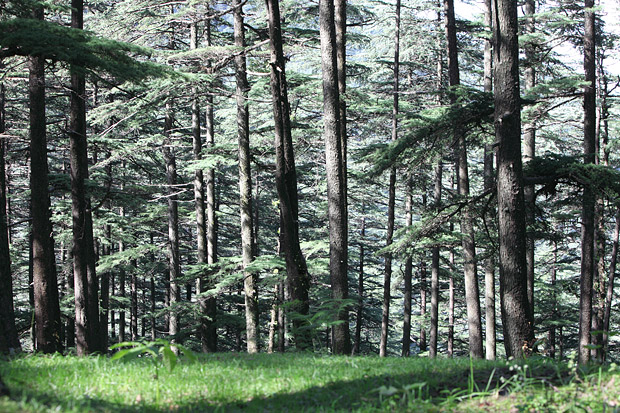
Deodars forest on the way to Chail
Chail was a place I looked forward to seeing again. I had fallen in love with its thick cedar forests when I was there three years ago (Read: my previous visit to Chail). When I first saw the market in the center of the town, it had given me an impression that there could be a large sprawl of shops out there. But I was taken by surprise to see the buildings vanish on a bend making way to another expanse of cedars. With a blanket ban on construction activity here, the quiet woods, the tall trees, the idle village had remained unchanged and unaffected by the rush of tourists since my last visit. Except for a minor addition. Someone had added an addition zero to the entry fee to Chail Palace, which then used to cost Rs.10/- Now, a fading sign at the gates said 100/- and helpfully mentioned that it can be reimbursed against accommodation charges. I reminded myself not to forget the reimbursements the next time I come here to stay at the Maharaja Suite. Just for the record, it costs about 15,000.
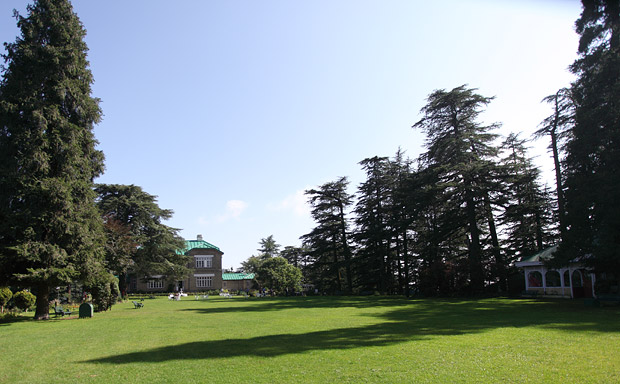
The palace built by Maharaja of Patiala in Chail
I was still thinking about Chail when we went camping in the middle of cedar trees next evening. It was a tad luxurious for a camp, but was a cozy place for a good conversation around the warmth of the fire. Much food was consumed as the well read and well travelled folks prattled on William Dalrymple, Amitav Ghosh, Gerald Durrell, Che Guevara, Twain and Dickens and more. A smattering of that night’s conversation is documented here. I am told that the chatter progressed into a raucous cacophony till small hours of the morning, but I slept peacefully in my tent dreaming of cedar trees.
Next morning, strengthened by a breakfast of best ever Aloo Parathas I have ever had, we walked through a stretch of one such cedar forest to get back to the resort, loosing our way briefly before getting back on track and resisting insistences of one of us to try and chalk out a straight line path to the resort through the steep slopes. The rewards of the walk came in the form of a few encounters, like the one with a congenial elderly shepherd who conversed fondly with his dog, a few birds and a waterfall. Not to forget is the ‘feel good’ of the deodar forests.
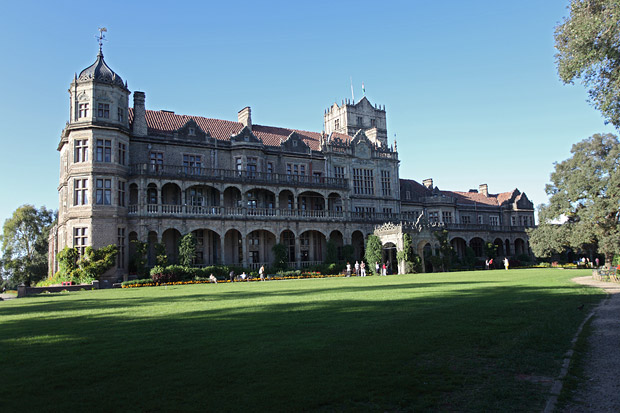
Viceregal Lodge, Shimla
Later in the day, we did what the tourists must do in Shimla – make a visit to the Viceregal Lodge and a walk up and down the mall (Read more: Walks in Shimla Mall Road, spending a day at Shimla Mall). While mall was a familiar territory, Viceregal lodge impressed and surprised me by its efficient construction and tastefully built exteriors. Raj Verma, the guide at the lodge showed us the furnishing and woodwork, electrical wiring and switches and decoratives that have survived the 121 years since the lodge was built. The foresighted architects of the lodge had implemented rainwater harvesting and had made provisions for electric wiring in the walls at a time when Shimla had no electricity at all. No wonder that the lodge is still used with very little modifications.
At the end of the touristy venture to Shimla, we were enslaved in the evening by the preparations of sous chef Vikas. I wonder what addictives he puts into his appetizers. I came to the restaurant every night with a resolve to eat very little, but never manage to stop before I could take no more. And when it comes to saying ‘thank you,’ I must not forget the tireless resort manager Mohnish.
The visit to Shimla and Mashobra ended just the way it started. We journeyed through the highway that seemed never-ending on a day that is easily the most boring one in the entire trip, even surpassing that uninspiring day when we waded past Shimla’s traffic towards Kasauli.
About Mashobra and Shimla
Mashobra is a small village, about 10km from Shimla on the Hindusthan-Tibet highway. The place has beautiful deodar forests and some great views of the mountain ranges. Read more about Shimla and surrounding places in an earlier post.
About the resort
Club Mahindra Whispering Pines Gables in Mashobra is a resort owned by Mahindra Holidays. Read more about the resort on Club Mahindra website.
